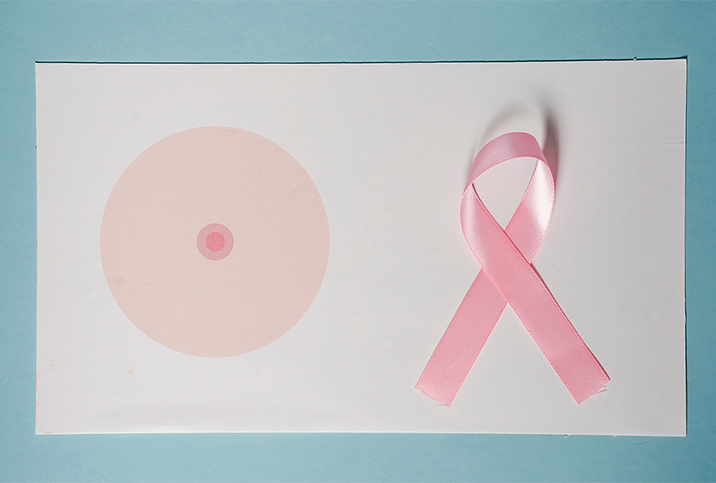What Are the Symptoms of Breast Cancer?

You or someone you know will likely have breast cancer at some point in your life. It’s scary to think about but hard to ignore. Other than skin cancer, breast cancer is the most common type of cancer in the United States.
That’s a big reason breast cancer awareness, education and screenings are all so important.
Breast cancer prevalence
Statistically, 1 in 8 women will receive a breast cancer diagnosis, and a smaller number of males will. Roughly 5 percent of people are diagnosed with stage IV cancer. The other 95 percent receive their diagnosis earlier, before it metastasizes.
Detecting it sooner rather than later is always best. The five-year relative survival rate for breast cancer is 99 percent if it is detected in the localized stage and 86 percent at the regional stage.
The most prominent early warning sign of breast cancer is a breast lump.
"Although there are many different presentations of breast cancer, a palpable lump is the most common and can occur within the breast to the armpit," said Kenneth Meng, M.D., a diagnostic radiologist with the Center for Cancer Prevention and Treatment at Providence St. Joseph Hospital in Orange County, California.
Breast cancer screening
"Not every lump is breast cancer, as benign cysts or fibroadenomas can also be felt on [a] physical exam," Meng said. "However, it is important to have any lump checked out."
Guidelines as to whether to have a clinical breast exam—a physical examination by a doctor—vary.
The National Comprehensive Cancer Network recommends clinical breast exams every one to three years for asymptomatic women of average risk—ages 25 to 39—and yearly for asymptomatic women of average risk age 40 and above.
The U.S. Preventive Services Task Force (USPSTF), however, no longer recommends clinical breast exams. Speak with your doctor to determine your best course of action.
If you notice a lump or a thickening of your breast tissue during a self-exam, contact your doctor. Not every person with breast cancer will feel a lump, however.
What are the other breast conditions you may notice?
"Usually, you’ll notice a lump or mass, new or changed nipple discharge, [or] changes in the skin of the breast, such as [it] turning red, swelling or puckering," said Laura Farrington, D.O., a medical oncologist at City of Hope Chicago.
Once breast cancer becomes metastatic, new symptoms may appear. They will depend on where the cancer cells have traveled, such as the bones, lungs, brain or liver.
The common symptoms of breast cancer include bone pain, fatigue, weight loss, coughing or shortness of breath, jaundice, seizures, headaches and vision changes, too, according to Farrington.
"Many breast cancers are now diagnosed on imaging alone, meaning we see them on a routine screening mammogram or ultrasound before the patient has any symptoms," said Linda M. Pak, M.D., a surgical oncologist at NYU Langone Perlmutter Cancer Center in New York City.
Breast cancer risks and complications
"When diagnosed early with screening mammograms, before they become palpable, long-term survival and cure rates are very good," Meng said.
As with other kinds of cancer, one of the primary concerns is it spreading.
"The most common places for breast cancer to spread are to the bones, liver, lungs and brain, but any organ can be affected," Farrington shared.
In turn, you may experience some of those metastatic symptoms, as well as liver failure, anemia and seizures. Once the cancer has spread to other body parts, said Linda M. Pak, M.D., a surgical oncologist at NYU Langone Perlmutter Cancer Center, it can only be treated, not cured.
What are the risk factors of breast cancer?
Many factors can contribute to the growth of abnormal breast cells, including, according to Farrington:
- Prolonged estrogen exposure (your period starting early, menopause starting later)
- Hormone replacement therapy, such as menopausal hormone therapy
- Age
- Having a particular benign breast condition such as atypical hyperplasia
- Radiation exposure
- Family history
- Obesity
Studies suggest prolonged use of systemic menopausal hormone therapy can factor into a person’s risk of cancer.
However, you can have breast cancer without any of those factors.
"It is important to note that many diagnosed with breast cancer have no risk factors other than having breasts, making it vital for all women to get screened," Farrington said.
Screening mammograms
Meng said women should get their first mammogram at age 40, which lines up with NCCN's recommendations.
“If performed for screening, intervals of every one to three years for women ages 25 to 39 years and annually for women 40 years and older are reasonable," according to The American College of Obstetricians and Gynecologists (ACOG). "The clinical breast examination continues to be a recommended part of the evaluation of high-risk women and women with symptoms."
Even with regular screenings and self-exams, reducing your odds of developing breast cancer is partially within your control. You can potentially reduce your risk of breast cancer and help minimize your chance for other diseases of the breast by following a few general guidelines to improve your overall wellness.
Maintain a healthy weight and stay active. Avoid alcohol and speak with your doctor about other ways to potentially help reduce your risk.
Testing and diagnosis of breast cancer
Once you notice symptoms, let your doctor know. As part of the next step in your evaluation, they’ll use ultrasounds, mammograms and magnetic resonance imaging (MRI) to figure out the size and shape of the lump, while looking for suspicious features. A biopsy is often necessary to determine if a lump is cancerous.
"Diagnosis comes from a biopsy," Farrington said. "A crucial point is this: Mammograms can catch breast cancer prior to any symptoms and are an important screening tool."
"A small sample of the tissue is removed and evaluated under the microscope," Pak explained. "Once the diagnosis of breast cancer is confirmed, the patient will be referred to a breast cancer specialist for evaluation and treatment."
If the biopsy is positive for cancer, your doctor will do more tests to see if it has spread.
"Further testing may include a breast MRI and body scans, including CT scans, a bone scan or even a PET scan, depending on cancer type and risk of spread," Farrington added.
The bottom line
If you are concerned you have the symptoms of breast cancer, don’t wait. Get a mammogram scheduled. No matter the type of breast cancer you’re dealing with, its stage and where you live, you’re never alone.


















